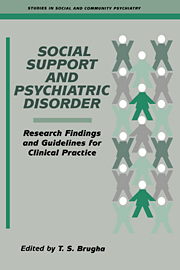Book contents
- Frontmatter
- Contents
- Preface
- List of contributors
- 1 Social support and psychiatric disorder: overview of evidence
- PART I CONCEPTS AND ORIGINS OF SOCIAL SUPPORT
- PART II LESSONS FROM SELECTED OBSERVATIONAL STUDIES
- PART III LESSONS FROM INTERVENTION STUDIES
- 9 Social network and mental health: an intervention study
- 10 A test of the social support hypothesis
- 11 Case management and network enhancement of the long-term mentally ill
- 12 Expressed Emotion: measurement, intervention and training issues
- PART IV INTERVENTION PRINCIPLES AND RECOMMENDATIONS
- Index
12 - Expressed Emotion: measurement, intervention and training issues
from PART III - LESSONS FROM INTERVENTION STUDIES
Published online by Cambridge University Press: 31 October 2009
- Frontmatter
- Contents
- Preface
- List of contributors
- 1 Social support and psychiatric disorder: overview of evidence
- PART I CONCEPTS AND ORIGINS OF SOCIAL SUPPORT
- PART II LESSONS FROM SELECTED OBSERVATIONAL STUDIES
- PART III LESSONS FROM INTERVENTION STUDIES
- 9 Social network and mental health: an intervention study
- 10 A test of the social support hypothesis
- 11 Case management and network enhancement of the long-term mentally ill
- 12 Expressed Emotion: measurement, intervention and training issues
- PART IV INTERVENTION PRINCIPLES AND RECOMMENDATIONS
- Index
Summary
I almost hoped he would get run over. That would be better than this person dying and yet reappearing with another personality. It's just hell.
(Mother talking about her son. Evidence of hostility as rejection)It's brought us together … As time goes on he's coming back, never 100%, but he's getting better and we'll wait and see.
(Mother talking about her son. Evidence of warmth)She's a really nice person.
(Mother talking about daughter. Positive remark)I will never get over the shock [of the illness].
(Mother talking about son. Evidence of emotional overinvolvement)He became violent on a couple of occasions, smashed winders, smashed doors, nice antique chairs I had, several clocks, my radio. Everything my wife bought me he seemed to smash.
(Father talking about son. Critical comment)He's verbally very critical, accusing, or just blatantly disregards what you are saying, just refuses to listen.
(Staff member talking about key patient. Critical comment)Introduction
The topic of social support is a broad one, and many authors have referred to the literature on Expressed Emotion (EE) as one of its aspects. It is appropriate, therefore, that while discussing the research literature on social support in psychiatric disorder, and its implications for intervention, an overview on EE should be included. In this chapter I will focus on the measurement of EE and the range of social interventions it has generated, and discuss a model of training in these interventions which has been developed.
Keywords
- Type
- Chapter
- Information
- Social Support and Psychiatric DisorderResearch Findings and Guidelines for Clinical Practice, pp. 257 - 276Publisher: Cambridge University PressPrint publication year: 1995
- 1
- Cited by

